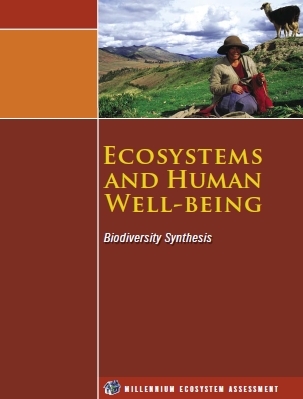Ecosystems and Human Well-being: Biodiversity Synthesis: Appendix A. Abbreviations, Acronyms, and Figure Sources
This is part of the Millennium Ecosystem Assessmentt report Ecosystems and Human Well-Being: Biodiversity Synthesis
Extended Writing Team: MA Coordinating Lead Authors, Lead Authors, Contributing Authors, and Sub-global Assessment Coordinators
Review Editors: José Sarukhán and Anne Whyte (co-chairs) and MA Board of Review Editors
Abbreviations and Acronyms
AM – Adapting Mosaic (scenario)
CBD – Convention on Biological Diversity
CO2 – carbon dioxide
CONABIO – National Commission for the Knowledge and Use of Biodiversity (Mexico)
GDP – gross domestic product
GO – Global Orchestration (scenario)
INBio – National Biodiversity Institute (Costa Rica)
IPCC – Intergovernmental Panel on Climate Change
IUCN – World Conservation Union
LULUCF – land use, land use change, and forestry
MA – Millennium Ecosystem Assessment
MDG – Millennium Development Goal
NGO – nongovernmental organization
NOx – nitrogen oxides
NWFP – non-wood forest product
OECD – Organisation for Economic Co-operation and Development
OS – Order from Strength (scenario)
PA – protected area
TDR – tradable development rights
TEV – total economic value
TG – TechnoGarden (scenario)
TSR – total species richness
UNFCCC – United Nations Framework Convention on Climate Change
Figure Sources
Most Figures used in this report were redrawn from Figures included in the technical assessment reports in the chapters referenced in the Figure captions. Preparation of several Figures involved additional information as follows:
Figures 1.2 and 1.3
- These figures present the 14 biomes of the WWF terrestrial biome classification, based on WWF terrestrial ecoregions: Olson, D. M., E. Dinerstein, E. D. Wikramanayake, N. D. Burgess, G. V. N. Powell, E. C. Underwood, J. A. D’Amico, I. Itoua, H. E. Strand, J. C. Morrison, C. J. Loucks, T. F. Allnutt, T. H. Ricketts, Y. Kura, J. F. Lamoreux, W. W. Wettengel, P. Hedao, and K. R. Kassem, 2001: Terrestrial ecoregions of the world: a new map of life on earth. BioScience, 51, 933–938. </dd>
Figure 2.1
- This figure was developed from material cited in R17: Polasky, S., E. Nielson, E. Lonsdorf, P. Fackler and A. Starfield. Conserving Species in a Working Lanscape: Land Use with Biological and Economic Objectives. Ecological Applications (in press). </dd>
Figures 3.4 and 3.5
- These figures were developed from BirdLife International material cited in C4 and C20: Butchart, S. H. M., A. J. Stattersfield, L. A. Bennun, S. M. Shutes, H. R. Akçakaya, J. E. M. Baillie, S. N. Stuart, C. Hilton-Taylor, and G. M. Mace, 2004. Measuring global trends in the status of biodiversity: Red List Indices for birds. Philosophical Transactions, LoS Biology. </dd>
Figure 3.7
- The source figure (C20 Fig 20.12) is derived from the Living Planet Index in: Loh, J., and M. Wackernagel, eds., 2004: The Living Planet Report 2004. Gland, Switzerland: World Wide Fund for Nature and Cambridge, UK: UNEP-WCMC. </dd>
Figure 3.11
- This figure was developed from figure 4.3 in: Scholes, R. J., and Biggs, R. (eds) 2004: Ecosystem Services in Southern Africa: A Regional Assessment. The Regional-Scale Component of the Southern African Millennium Ecosystem Assessment. CSIR, Pretoria, South Africa. </dd>
Figure 3.15
- This figure was developed from material cited in C4: Wade, T. G., K. H. Riitters, J. D. Wickham, and K. B. Jones. 2003. Distribution and causes of global forest fragmentation. Conservation Ecology 7(2): 7. Online at: www.consecol.org/vol7/iss2/art7. </dd>
Figure 3.16
- The source figure (C20 Fig 20.12) is based on data and maps provided in: Revenga, C., J. Brunner, N. Henninger, K. Kassem, and R. Payne, 2000: Pilot Analysis of Global Ecosystems: Freshwater Systems, World Resources Institute, Washington D.C., 83 pp.</dd>
Figures 3.17 and 3.18
- The source figures (S7 Fig 7.16 and 7.18) were developed from IFADATA statistics, downloaded from www.fertilizer.org/ifa/statistics.asp. </dd>
Figure 3.19
- The source Figure (R9 Fig 9.2) was modified to include two additional deposition maps for 1860 and 2050 that had been included in the original source for R9 Fig 9.2: Galloway, J. P., et al., 2004, Biogeochemistry 70: 153–226. </dd>
Figure 3.20
- The source figure (S7 Fig 7.13) is based on: IPCC 2002: Climate Change 2001: Synthesis Report. Cambridge University Press, Cambridge. </dd>
Figures 4.2 and 4.3
- These figures use the IMAGE land-cover biome classification, which differs from the WWF terrestrial biomes used in figures 1.2 and 1.3, and is a modified version of the BIOME model: Prentice, I. C., W. Cramer, S. P. Harrison, R. Leemans, R. A. Monserud and A. M. Solomon, 1992. A global biome model based on plant physiology and dominance, soil properties and climate. Journal of Biogeography, 19, 117–134. Further information on the IMAGE model is available from www.rivm.nl/image </dd>
Figure 4.4
- This figure incorporates historical changes in the WWF biomes as per figures 1.2 and 1.3, with changes under the MA scenarios using the biome classification of IMAGE, as used in figures 4.2 and 4.3. </dd>
Figure 4.6
- This figure was developed using data present in S9 and prepared by the Center for Environmental Systems Research, University of Kassel. </dd>
Terms of Use
The copyright for material on this page is the property of the World Resources Institute. Click here for the Terms of Use (Ecosystems and Human Well-being: Biodiversity Synthesis: Appendix A. Abbreviations, Acronyms, and Figure Sources).
Disclaimer: This chapter is taken wholly from, or contains information that was originally written for the Millennium Ecosystem Assessment as published by the World Resources Institute. The content has not been modified by the Encyclopedia of Earth.
|
|
